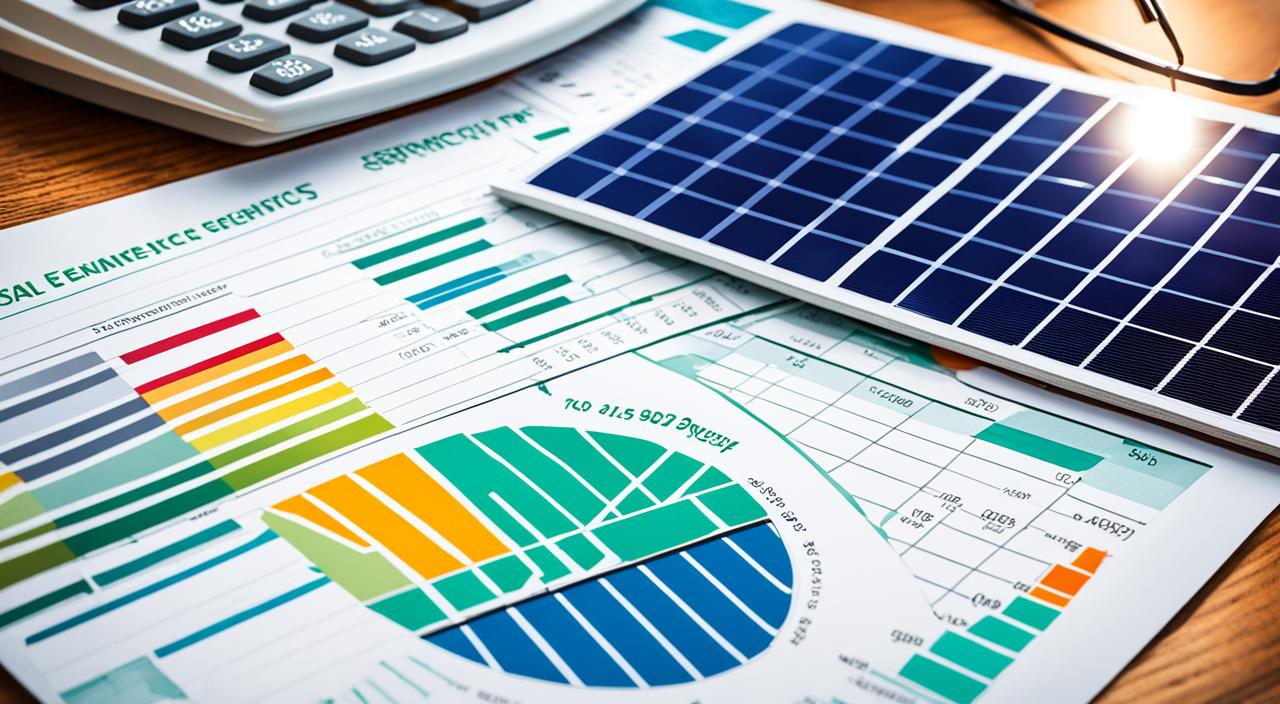Solar Financing
Solar power is becoming a top choice for both homes and businesses in the U.S. due to its cost-effectiveness and green benefits. Yet, the initial cost of solar panels can be high, making it hard for many to start. This guide will cover the various ways to finance solar power. We aim to help you make a smart choice and enjoy the savings solar energy offers.
Key Takeaways
- Explore the different solar financing options, including loans, power purchase agreements, and leasing.
- Understand the federal and state incentives, tax credits, and rebates available to offset the cost of solar installations.
- Learn how to evaluate the long-term savings and return on investment of solar energy projects.
- Discover tips for working with reputable and reliable solar financing providers.
- Embrace solar financing as a key step towards a more sustainable future.
The Rise of Solar Energy
In the U.S., the need for solar energy is growing. People want to lower their carbon footprint and save money over time. Solar power is becoming a key part of our energy mix. It’s good for the planet and can save money, making it popular among many.
The Environmental and Economic Benefits
Solar energy is clean and renewable. It cuts down on greenhouse gases and helps the environment. Using the sun’s power means no more burning fossil fuels, which is good for the planet.
It also saves money, making it a smart choice for homes and businesses. This could lead to lower electricity bills in the future.
Solar Adoption Trends and Projections
- The U.S. solar market grew by 42% in 2020, says the Solar Energy Industries Association (SEIA).
- More than 2.7 million solar installations happened in homes across the country.
- Experts believe solar energy will keep growing. The U.S. Department of Energy thinks it could make up to 45% of our electricity by 2050.
Solar energy is becoming more popular. This could change how we use energy and help make our future greener.

“The growth of solar power in the U.S. has been nothing short of remarkable. As more homeowners and businesses recognize the environmental and economic advantages, we’re seeing a surge in solar energy adoption that is truly transforming the way we power our homes and communities.”
Understanding Solar Financing
Before looking into solar financing options, it’s key to know what affects the cost of a solar energy system. This info helps you pick the best financing for your budget and needs.
When looking at solar energy costs, think about the initial cost, ongoing expenses, and savings over time. The size of your system, the equipment type, installation costs, and local rates can change the investment.
With a clear idea of what you need for solar financing, you can check out the different financing options. These include solar loans, power purchase agreements (PPAs), and solar leasing. Each has its own pros and cons.
Evaluating Solar Financing Options
When looking at solar financing options, keep these factors in mind:
- Initial upfront costs and the available financing terms
- Potential long-term savings on your electricity bills
- The impact of solar incentives, rebates, and tax credits
- The overall return on investment (ROI) and payback period
By looking at these factors, you can find the solar financing option that fits your financial goals and energy needs. This ensures a smooth move to solar energy.

Solar Loans: Financing for Residential Installations
A solar loan is a popular way for homeowners to get solar energy systems. These loans help you pay for the system over time. This makes solar energy more affordable for those without the money upfront. Let’s look at the different loan types and terms. We’ll also discuss what to think about when picking your loan options.
Loan Types and Terms
There are many solar loans to choose from, each with its own benefits. Some common loan types are:
- Home equity loans or lines of credit
- Personal loans
- Solar-specific loans, often given by solar installers or lenders focused on solar
The loan terms vary, with repayment times from 5 to 20 years. It’s important to look at the interest rates, fees, and total loan cost. This ensures the loan fits your budget and energy savings goals.
Evaluating Loan Options
When looking at loan options for your residential solar setup, consider these key points:
- Interest rates: Look for the best rates from different lenders.
- Loan term: Longer terms mean lower monthly payments but more interest over time.
- Fees and closing costs: Know any upfront fees or costs when you close the loan.
- Energy savings: Make sure the loan fits your budget by calculating your energy savings.
- Tax credits and incentives: Check out federal, state, or local solar incentives to lower your costs.
By carefully looking at your loan options, you can find the best way to finance your residential solar setup.
“Solar loans have made residential solar installations much more accessible for homeowners who don’t have the upfront capital to purchase a system outright.”
Solar Power Purchase Agreements (PPAs)
Businesses are turning to solar power purchase agreements (PPAs) as a new way to get renewable energy. PPAs let companies use solar energy without paying for it upfront. This is great for businesses and industrial properties looking to go green.
How PPAs Work
A third-party solar provider installs and maintains a solar system on a customer’s property. The customer then buys the electricity at a set rate, usually lower than what the local utility charges. This way, businesses can use solar power without owning or maintaining the system.
- The solar provider pays for the system’s setup and owns it.
- The customer buys the electricity at a fixed rate, often lower than the local utility’s.
- The provider takes care of the system’s upkeep, repairs, and maintenance.
This financing option makes solar energy more available to businesses. It helps those with limited funds or concerns about the high upfront costs of solar. With solar PPAs, companies can meet their solar financing for businesses goals easily.
“Solar PPAs offer a smart and cost-effective way for businesses to go green without the burden of upfront capital investment.”
Solar Leasing: An Alternative Financing Option
Homeowners are now looking at different ways to switch to renewable energy. Solar leasing is one option that lets people enjoy solar power without the high upfront costs. It’s a way to get into solar panel leasing easily.
With solar leasing, homeowners lease solar panels from a company. This means they don’t need to pay a lot upfront. The company takes on the initial cost, making residential solar financing easier for more people.
The Advantages of Solar Leasing
- Low or no upfront costs, making solar power more accessible
- Predictable monthly payments, often lower than traditional utility bills
- Maintenance and repair responsibilities handled by the leasing company
- Potential for homeowners to take advantage of tax credits and incentives
Considerations for Solar Leasing
- Homeowners may not own the solar system, limiting their ability to sell the property
- Lease terms can vary, so it’s essential to carefully review the contract
- Homeowners may not benefit from the long-term savings that come with system ownership
When looking at solar financing, it’s important to compare solar leasing with other options like loans or power purchase agreements (PPAs). Knowing the details of each option helps homeowners choose the best one for their energy and financial plans.
| Feature | Solar Leasing | Solar Loans | Solar PPAs |
|---|---|---|---|
| Upfront Costs | Low to No | Moderate to High | No Upfront Costs |
| Monthly Payments | Predictable Lease Payments | Loan Repayments | Electricity Payments |
| System Ownership | Leasing Company | Homeowner | Third-Party Provider |
| Tax Credits/Incentives | Leasing Company | Homeowner | Third-Party Provider |
Solar Financing for Commercial and Industrial Projects
Businesses and industrial facilities are turning to solar power, but they face special challenges with solar financing. They need to understand commercial solar financing, industrial solar financing, and solar financing for businesses. We’ll look into these unique needs and how to find the right financing options.
Navigating the Complex Landscape
Commercial and industrial solar projects are big and costly. They need a special approach to financing. Businesses must think about taxes, energy use, and finding solutions that fit their energy needs.
- Looking into commercial solar financing for your business
- Understanding the special challenges of industrial solar financing
- Checking out the solar financing for businesses options
To get through this complex world, businesses often work with solar financing experts. These pros help pick the best financing, deal with rules, and make sure the project works long-term.
| Financing Option | Advantages | Considerations |
|---|---|---|
| Commercial Solar Loans | – Keep money for other business needs – Could get tax benefits |
– Needs good credit and something to use as collateral – How you pay back can change |
| Power Purchase Agreements (PPAs) | – No money down – Know what you’ll pay for energy |
– You’re locked in for a long time – You have to negotiate a lot |
| Solar Leases | – Less money upfront – Could get tax benefits |
– You pay every month – You don’t fully own the system |
By looking at these options and teaming up with good solar financing experts, businesses and industrial places can use commercial solar financing, industrial solar financing, and solar financing for businesses. This helps them move towards a greener future.
Solar Incentives and Tax Credits
Solar energy can be more affordable thanks to various incentive programs and tax credits. In the U.S., both federal and state incentives help lower the cost of solar systems. This makes solar energy more appealing for homeowners and businesses.
Federal Solar Incentives
The main solar incentive at the federal level is the Investment Tax Credit (ITC), or the federal solar tax credit. It lets homeowners and businesses deduct a part of their solar system’s cost from their taxes. For systems installed in 2023 and 2024, the ITC is 26%. It will drop to 22% in 2025 and might end after that.
State Solar Incentives
Many states also offer their own solar incentives. These can include:
- Solar rebates, which give cash to help cover the cost of solar systems
- Performance-based incentives, which pay based on how much energy the system makes
- Solar renewable energy credits (SRECs), which can be sold for more money
- Property tax exemptions, which remove the tax increase from installing a solar system
- Sales tax exemptions, which don’t charge sales tax on solar system purchases
These state solar incentives differ across the country. It’s key for people and businesses to check what’s available in their area.
| Incentive Type | Description | Example States |
|---|---|---|
| Solar Rebates | Direct cash payments to offset the cost of a solar energy system | California, New York, Massachusetts |
| Performance-Based Incentives | Ongoing payments based on the system’s energy production | New Jersey, Maryland, District of Columbia |
| Solar Renewable Energy Credits (SRECs) | Tradable credits that can generate additional revenue | Pennsylvania, Ohio, Delaware |
Using both federal and state solar incentives and solar tax credits can cut the cost of solar systems. This makes solar energy a better investment for people and businesses.
Solar Rebates and Other Financial Assistance
Exploring solar energy financing shows us that tax credits and incentives are just the start. There are many solar rebates and financial help programs to make solar energy cheaper. These programs can cut down the cost of going green.
State and local governments give solar rebates to people and businesses who put in solar panels. These rebates can save a lot of money, often covering part of the setup costs. Some utility companies also offer their own rebate programs to encourage using solar energy.
There’s more than just rebates for solar financial assistance. Some programs offer low-interest loans or grants to help pay for solar systems. These are great for people or small businesses that can’t afford the full solar setup cost right away.
Using these solar energy cost-saving chances, people and businesses can get the most out of renewable energy. This leads to more solar adoption and helps us move towards a greener future.
“The future is solar, and the time to embrace it is now. With the right financial assistance, the path to a clean energy future is within reach.”
Solar Financing
Exploring solar energy can be exciting, but the costs can seem high. Luckily, there are many solar financing options for homeowners and businesses. We’ll look at different ways to finance your solar project. This will help you choose the best option for your energy goals and budget.
Exploring Solar Loan Options
Solar loans are a popular choice for financing. They provide funds for the upfront costs of solar systems. These loans have competitive interest rates and flexible repayment plans. This makes them a good option for those wanting to own their solar system.
Leasing and Power Purchase Agreements (PPAs)
If you don’t want to pay for a solar system upfront, leasing and PPAs are good alternatives. With leasing, a company installs and maintains the system for you. You pay them monthly. PPAs work differently. The company owns and runs the system, and you buy the electricity at a lower rate than your current bills.
Incentives and Tax Credits
States and the federal government offer incentives and tax credits for solar energy. These can include rebates, tax credits, and other benefits. They can lower the solar energy cost for homes and businesses.
Looking at the different solar financing options can help you find the right one for your needs and budget. This way, you can use the sun’s power and enjoy the benefits of clean energy.
Evaluating the Long-Term Savings
Looking into solar financing means checking out the long-term savings and the return on your investment (ROI). Solar energy is now more affordable, making it a wise choice for both homes and businesses. Knowing about solar energy savings and solar ROI helps you decide on your solar project. It ensures it’s a good deal financially.
Calculating the Return on Investment
To figure out your solar system’s ROI, think about a few things. These include the system’s initial cost, the savings on energy over time, and any tax credits or incentives you might get. Here’s a simple guide to find the ROI:
- First, figure out the total cost of your solar system. This includes installation and any financing fees.
- Then, calculate your yearly savings by subtracting your solar bills from your current bills.
- Remember to add any tax credits, rebates, or incentives that can cut down the system’s cost.
- Next, divide the system’s total cost by your yearly savings (with incentives) to find the payback period.
- The ROI is the percentage of your initial investment you’ll get back over the system’s life.
By looking at the solar energy savings and solar ROI, you can decide if your solar project is a good long-term investment.
| Factors | Example Values |
|---|---|
| Initial Cost of Solar System | $20,000 |
| Annual Energy Savings | $1,500 |
| Federal Tax Credit | $5,000 |
| Payback Period | 10 years |
| ROI | 50% |
The table shows a case where a solar system costs $20,000 at first. It saves $1,500 a year and gets a $5,000 tax credit. The payback period is 10 years, and the ROI is 50%.
By looking at the solar energy savings and solar ROI, you can make a smart choice about your solar project’s long-term value.
Working with Solar Financing Providers
Finding the right solar financing providers is key for a smooth solar energy setup. It’s important to pick trustworthy solar financing partners. Here are some tips to find the best solar financing companies for you.
Evaluating Solar Financing Providers
When looking at solar financing providers, think about these things:
- Experience and track record: Choose solar financing partners with a good history of successful projects and happy customers.
- Financial stability: Make sure the solar financing company is stable and can fund your project.
- Transparency and communication: Pick solar financing providers who are open about their terms, fees, and how they finance projects.
- Customer service: Look for solar financing partners who are quick to respond, helpful, and focused on your needs.
Comparing Financing Options
After picking a few solar financing providers, compare what they offer. Think about:
- Interest rates and loan terms
- Upfront costs and fees
- Flexibility in payment plans and options
- Available incentives and tax credits
By carefully looking at and comparing solar financing companies, you can find the best one for your solar project and budget.
Working with reputable and reliable solar financing providers is crucial for your solar journey. Do your homework and choose the right partner to help you get the most from solar energy.
Conclusion: Embracing Solar Financing for a Sustainable Future
Looking into solar financing shows us that going green is smart for our wallets and the planet. By using the sun’s power, we can create a future filled with sustainable energy. This is good for Earth and our bank accounts.
Homeowners, business owners, and community leaders can all find a way to change their energy use with solar financing. There are many options like solar loans, power purchase agreements, leasing, and commercial financing. Each one is designed to fit the specific needs of different people and groups.
Switching to renewable energy does more than save money. It also cuts down on pollution and helps the clean energy sector grow. This means we’re making a better world for now and the future. Start making a change by looking into solar financing that suits you. Begin building a greener, stronger future today.

